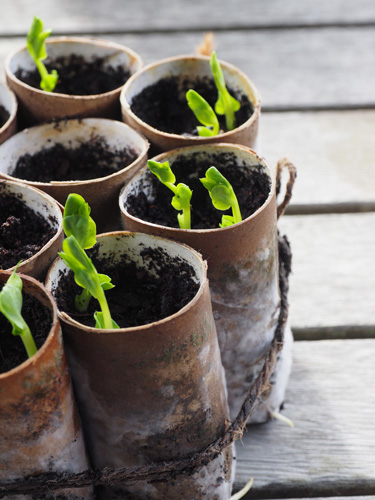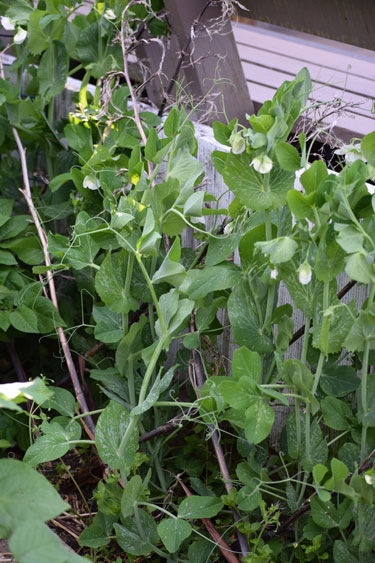Grow peas
Peas are favourite winter grown crop and especially fun for kids who are usually delighted to discover that peas actually come from little green packages call pods, not just frozen in plastic bags.
Peas are best grown from seed sown directly into cool soil. Planting is timed to avoid flowering in frosty or hot dry weather. Also, cool but not heavy wet soil is needed for successful germination. Therefore, autumn or winter sowing is ideal for peas in a warm climate garden, whereas spring sowing suits a cold climate.
How to grow peas
- Choose a sunny spot with well-drained garden soil or a large pot filled with good quality container mix.
- Make a teepee or climbing frame for your peas to grow on. Use bamboo stakes and string, find twigs and branches around the garden, or make a trellis or wire netting climbing frame. Google for ideas. Once your pea seedlings grow tendrils they will cling to their support all by themselves.
- Plant seeds about 2cm deep and 10cm apart next to their support.
- Keep the soil just moist (not wet).
- Apply slug bait to protect young seedlings from slugs and snails.
- When the seedlings are 5-10cm high, feed them with balanced liquid fertiliser. This will give them a strong start.
Tips
- Soften pea seeds by placing between damp paper towels overnight, this will help them germinate faster.
- Cover the soil around your pea plants with straw or compost to keep the roots cool and prevent the soil drying out. Peas have quite shallow roots, so they need lots of water.
- Avoid placing seed in direct contact with fertilisers, either by planting where a well-fertilised crop grew last year or using liquid fertiliser once the plants are actively growing. Most varieties require staking.
- Keep picking peas while they are young and tasty. The more you pick the more they will produce! The same goes for sweet pea flowers.
- Pea plants can make their own fertiliser by ‘fixing’ nitrogen in special root ‘nodules’. If you leave the roots in the soil, they will help feed the next veges you plant.
- Peas don’t like being transplanted but they can be started successfully in biodegradable pots made from toilet rolls. They can then be planted into the soil, pot and all, without disturbing the roots. The pot rots away as the plant grows.
Sweet peas
A bunch of sweet peas is one of the sweetest, freshest scents of spring and summer. Old-fashioned sweet pea varieties have a reputation for being the most fragrant, but there are lots of beautiful varieties to try.
Sow seed in autumn and they’ll grow over winter to flower in spring. Like other peas, sweet peas need cool soil for germination. However, the seedlings are killed by frost, so if your winter is cold and frosty, wait until spring to sow seed.
Sweet peas in a pot
You will need:
- Sweet pea seeds
- A large pot (about 50cm diameter)
- Planting mix
- Six 1.8m tall bamboo stakes
- String
- Sheep pellets
- Slow-release fertiliser
- Slug pellets
- Place the pot in a warm sunny spot.
- Fill the pot to about 3cm from the top with planting mix.
- Add four handfuls of sheep pellets and mix it in thoroughly. Sweet peas have a big appetite for nutrients.
- Make the tee-pee. Slide the bamboo stakes close into the sides of the container making sure they’re evenly spaced. Push them right to bottom of the pot. Tie the tops together with string.
- Plant the seeds. Make small holes 3cm deep, each of each stake. Drop 2 seeds into each and cover lightly. Water gently with a watering can.
- Scatter slug pellets and slow-release fertiliser over the top.
- As your seedlings grow, use your fingers to guide them onto you tee-pee.
- When your plants are growing strongly, feed them about once a week with liquid fertiliser and they’ll produce a continuous plentiful supply of beautiful flowers for picking.
Snow peas
The French call them ‘mangetoute’ which means ‘eat all’. The fabulous thing about snow peas and their close relatives, the snap peas is that they are eaten pod and all. Even the flowers and young shoots are edible. And then, if we use what’s left for compost or mulch, it feeds our soil; as with all legumes, snow peas convert nitrogen from the air into nitrogen in the soil.
Snow peas, snap peas and ordinary peas are all varieties of the same plant species, Pisum sativum. The difference is in their pods. When eaten young, the pods of snow peas and snap peas lack the tough fibrous layer that lines the walls of a normal pea pod.Snow peas have flat pods while snap peas, or ‘sugar snaps’ have fatter, more rounded pods.
Both grow best in cooler weather. They can be planted in autumn or winter in warm climates, otherwise in early spring as soon as the danger of a frost is passed. While more cold tolerant than other vegetables, the young seedlings will suffer in harsh frost. Generally snow peas are more heat tolerant than other peas. Plant in full sun, or half-day sun as the weather gets warmer.
Whether you are growing them in the garden soil or a large container filled with planting mix, plant seeds into their permanent position. For tall and climbing varieties put stakes in place before you sow, so that you don’t damage the roots once they are growing. Alternatively, plant them along a trellis or fence with wires or netting for support. Add fertiliser at planting time (slow release fertiliser or sheep pellets) and feed regularly with liquid fertiliser once the plants are growing.
Sow seeds in batches every few weeks for a continuous supply. Protect the young seedlings from slugs and snails.
For more information about snow peas and snap peas go to www.yates.co.nz or www.kingsseeds.co.nz
22-Apr-2016

Pea seedlings raised from seed in used toilet rolls

Peas supported by cut branches

"Easy Peasy" peas

"Easy Peasy" peas

Sweet peas


